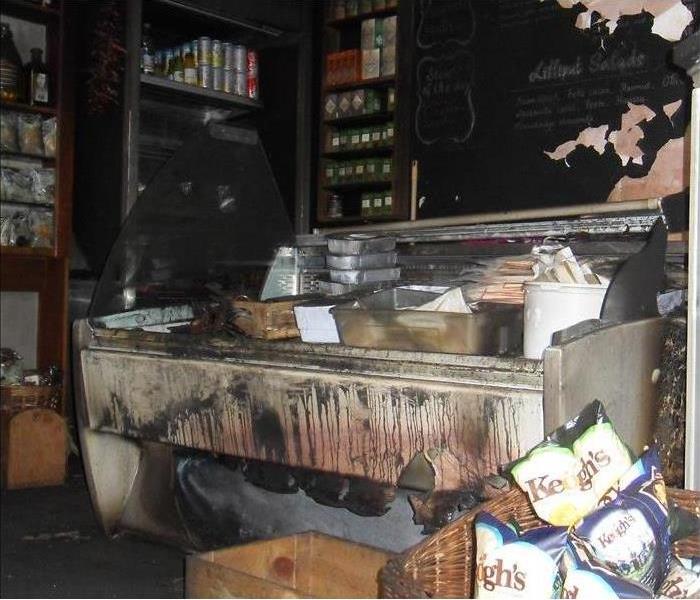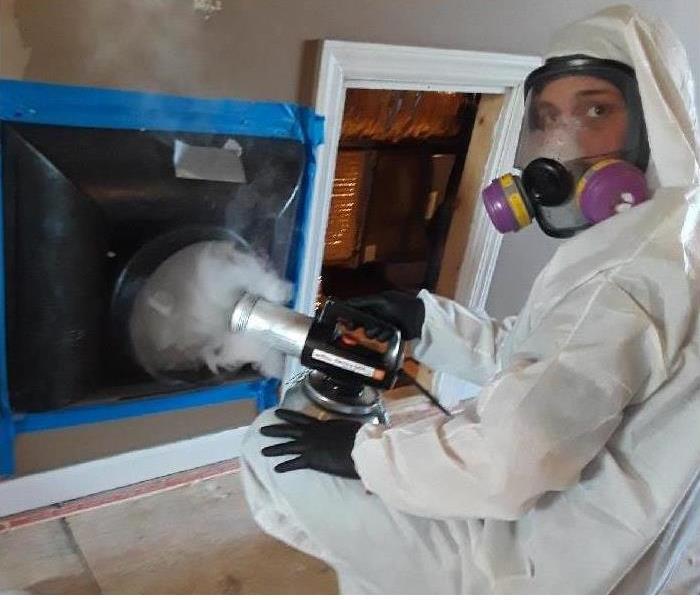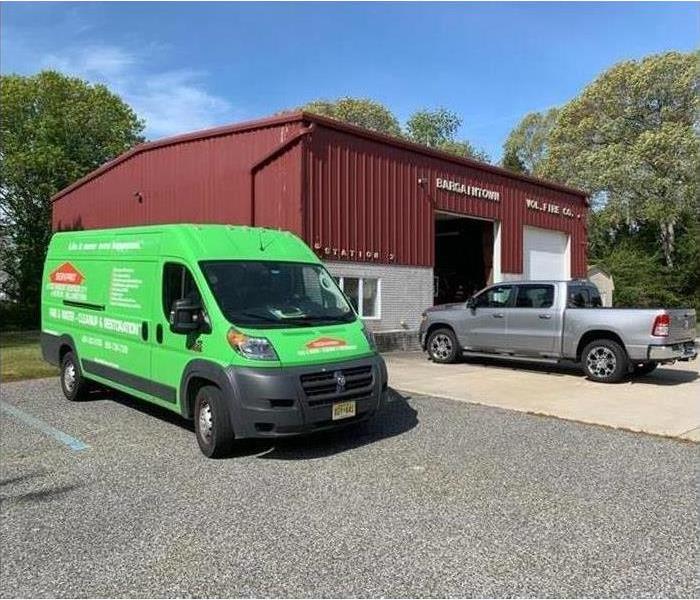Recent Commercial Posts
How To Use a Fire Extinguisher?
10/7/2022 (Permalink)
A Fire Extinguisher: How Do I Use One?
Fire extinguishers are one of the most important tools in every home and building. Having a fire extinguisher that is properly charged and ready to use can be critical in getting a fire extinguished while it's still small. That way, you don't need to call the fire department or wait for help—you can take care of the problem yourself! But where do you start? How do you know if your fire extinguisher has been serviced? And what exactly do I mean by that anyway? Here's everything you need to know about keeping your own fire extinguisher in good working order so it will be ready when an emergency strikes:
Step 1: Pull the pin. Most fire extinguishers use a pin to hold the handle in place
To use a fire extinguisher, you need to pull the pin. You probably know this already, but make sure you've actually done it before using it. If you don't pull the pin and then activate your extinguisher, it won't work at all.
Step 2: Aim low. Point the extinguisher at the base of the fire.
The next step is to aim low. You want to point the extinguisher at the base of the fire, so it won't affect surrounding items or property. This will help put out the flames faster and prevent any damage from occurring.
Step 3: Squeeze the lever slowly and evenly.
Once you've got the handle in your hand, make sure to hold it firmly and keep it level. Then, begin squeezing the lever slowly and evenly. If you have a Class A extinguisher (the most common type), don't overdo it—you're not trying to empty all of the contents onto the fire at once!
While you're squeezing, turn in a wide circle so that any flames that are near can be put out. Don't spray directly at them; instead, aim slightly above or below where they are burning. This helps prevent accidentally spreading those flames around more than necessary—and makes sure that no one gets burned in the process!
Step 4: Sweep side to side. Move the fire extinguisher back and forth until the fire is out.
If you are unsure, call the fire department.
The final step is to sweep side to side. This will help ensure that the fire is out and your home is safe again.
Knowing the type of fire you are dealing with is important.
You should know that the type of fire you are dealing with is important. Knowing how to use a fire extinguisher is also important because, if you don’t, you can endanger yourself and others.
It is vital that you have the right tools for the job, especially when it comes to putting out fires. It’s not just about getting rid of flames—you also need to take care of preventing damage by containing them so they don’t spread further and cause more damage than necessary.
Understanding how to use the fire extinguisher is important.
It is important to know how to use a fire extinguisher. You should not have to guess what type of fire you are dealing with and which fire extinguisher to use.
Do not just read the label or instructions on the back of your fire extinguisher, but also watch this video on how to use it properly! If there was an emergency, what would be your first step? Would you know where all of your family members are?
With these steps, you’ll be on your way to safely using a fire extinguisher. If you do choose to buy one for your home or office, make sure all the other people who might need to use it know how as well. For example, if there are kids in the house who can help put out fires and adults who can call 911 when necessary (like in an emergency), then everyone needs training!
Making a Fire Escape Plan
7/19/2022 (Permalink)
An emergency escape plan outlines the routes you should take to exit a building. It is excellent to have one in the event of a fire. This is because it not only helps with evacuation but can designate meeting and communication strategies as well. This should be part of any companies fire preparedness strategy. However, many questions come into play when you are creating one.
What Is an Emergency Evacuation Plan?
An emergency evacuation plan is basically a map posted throughout your building. It is designed to tell employees and customers the safest and fastest exit routes during a fire.
Why Should You Have One?
There are many reasons that you should have a fire escape plan for your business in West Berlin, NJ. The main motivators include:
- Quicker response times
- Improved employee safety
- Established chain of command
- Faster arrival of remediation professionals
How Often Should You Practice Your Plan?
Practice your exit plan at least twice per year. This ensures that all of your employees know the routes and your plan is still effective.
How Can You Draw the Maps?
To create the maps in your fire escape plan easily, you can use online templates. There are also map makers that you can use. This means you don't need any drawing or advanced technology skills.
Does It Improve Your Workplace Atmosphere?
By creating a plan, you are showing that you care about your employees. This will make your workplace feel more positive and can encourage employees to feel comfortable at work.
What Technology Do You Need to Make a Good Plan?
The simplest way to make a plan is by using online drawing tools. These operate on most computers, tablets, and phones. The only thing you will need to operate these is an internet connection. If you prefer to make your plan the old-fashioned way, you can use any office-type program.
Having a fire escape plan can improve your company's reaction to a disaster. This plan is easy to create thanks to online templates and should be practiced regularly for maximum effectiveness.
A Quick Guide for What To Do After a Fire
5/19/2022 (Permalink)
 Business fire in Clementon, NJ.
Business fire in Clementon, NJ.
Fire Restoration Process
Any fire is devastating. It can be hard for a business in Clementon, NJ to know where to start with the cleanup process. Here is a quick guide for getting the fire restoration process started as soon as possible.
Put Safety First
No fire restoration can start while the building is still smoking. While you may be in a rush to get the cleanup started, pause and consider these things first:
- Have fire personnel cleared the building and deemed it safe?
- Are your utilities turned off?
- Have you checked in on all of your employees?
- Did you arrange to secure the building?
These safety precautions should be observed before any cleanup begins. By failing to secure the building, you can complicate the claims process. Additionally, always put your employees first. Their well-being should be top of mind.
Call the Insurance Company
Once everyone and everything is safe, document the damages. To file a fire insurance claim, you'll need evidence of all the things that were lost in the fire. A representative will be able to walk you through the process. The more detail you can provide, the more quickly your insurance provider can resolve your case.
Trust a Professional with Smoke Cleaning
Now you can start to think about what comes next. If the building is still standing or if you were able to retrieve some possessions, soot cleaning is a big part of the restoration process. There will be constructed to replace damaged building materials, but the smell of smoke can linger and do more damage if it isn't dealt with correctly. A commercial fire restoration team can explain the process of cleaning smoke smell and soot damage at your building to help restore it and get you back to work.
Fire restoration after a disaster can be a lengthy process. A checklist of essential tasks will keep you on track to a grand reopening.
3 Tips for Handling a Musty Scent in Your Building
5/1/2022 (Permalink)
 SERVPRO of Berlin/Williamstown has a team certified to handle mold of all colors. We have the right equipment to clean it up, call us.
SERVPRO of Berlin/Williamstown has a team certified to handle mold of all colors. We have the right equipment to clean it up, call us.
3 Ways To Get Rid Of A Musty Smell In Your Building
Have you recently noticed or received complaints about a musty odor permeating the air in your commercial property in Clayton, NJ, but cannot identify a visible source? This may be a mold smell or a mildew smell.
Note that while mold and mildew are not technically the same, mildew is a type of mold, usually "early stage" or "young" mold growing flat; hereafter, the term "mold" will be used with the understanding that mildew is included in its usage.
Even if you do not see patches of it crawling along the walls in plain view, the ubiquitous mold is present in virtually every structure as spores in the air. The fungus smell is the result of the production of chemicals as mold grows and spreads. Since it indicates the presence of an organism capable of damaging a building's materials and structural integrity, it is important to deal with it as soon as possible. Here are some tips for doing so.
1. Contact a Professional
A professional cleanup and restoration service is more equipped to handle this kind of issue than an inexperienced individual. You should contact one to perform a thorough remediation of any areas the fungus has invaded.
2. Locate Potential Areas of Origin
The mold smell may originate from hidden places such as behind walls, in ceilings and under floors. Any area that is wet, cool and dark might harbor mold. Areas you should check include:
- Stairwells
- HVAC systems
- Bathrooms
- Storage areas
If you experience difficulty finding discernable signs of the fungus, a low-temperature range thermal/infrared camera can help identify concealed moisture that might be acting as a breeding ground for it.
3. Ventilate
After the professional has removed any mold found and sanitized its previous resting place, you should take measures to ventilate the rooms/building where it formerly resided. Examples of such actions include using fans and opening windows. This will help circulate fresh air while pushing out the musty air and dry up remaining moisture that might promote the return of the microbes.
Mold smell is less than ideal. However, with the aid of a professional, it can be dealt with easily.
Keep Your Business Going When Disasters Interrupt
3/15/2022 (Permalink)
 SERVPRO has storm damage restoration experience and specialized equipment to restore your home or business back to pre-storm condition
SERVPRO has storm damage restoration experience and specialized equipment to restore your home or business back to pre-storm condition
When Disasters Strike, Keep Your Business Running
When you’re trying to run a successful business in Williamstown, NJ, you can’t always afford the downtime brought by unexpected emergency situations such as flooding, storm damage and fire. That’s why having a continuity plan is extremely important for developing businesses of all shapes and sizes. A good plan should include a few key points:
- A thorough analysis on how downtime and damages will impact your business
- A number of strategies concerning recovery and restoration
- Concrete development of the chosen recovery plans
- Testing and exercises that keep the plan effective
Analyzing Your Business
During your initial analysis, there are a few key points you should zero in on to get the most out of this first step. Your critical business functions are what you should focus on the most closely. Is there anything within the scope of your business that the whole company simply can’t operate without? Consider elements such as vital data, employees, furniture, or office space. Regardless of what, exactly, your most crucial assets are, finding ways to save these parts of your business should be the primary goal of your entire continuity plan. Looking up resources for analyzing and creating a plan of this nature can be extremely useful if you’ve never made one before.
Testing Your Strategy
No strategy should be considered final until it’s tested and those involved have undergone training to prepare them to implement the plan when necessary. This period of time should be used to identify any pitfalls with your plan, so you can remedy them and proceed with confidence that you’ll be able to rely on your strategy while you’re dealing with building damages and obstacles.
Whether you’re doing something as simple as backing up data to the cloud or as complex as completely shifting production to another facility, you need to know that your continuity plan will actually be there and be functional in the event that disaster strikes in Williamstown, NJ. In the end, forming a plan may not be easy, but it’s the key to keeping your business’s doors open while dealing with unexpected emergencies in your normal routine.
Why Is IICRC Certification Important?
3/2/2022 (Permalink)
What Is The Importance Of IICRC Certification?
The standards for the restoration industry are set by the Institute of Inspection Cleaning and Restoration. A professional who holds this certification is prepared to use cutting-edge techniques and offer the highest standard of service. There are several reasons that the Preferred Vendors of insurance companies maintain IICRC credentials.
Industry-Wide Standards
The standards of this certifying agency are developed and maintained by leading restoration professionals. This organization collaborates with the American National Standards Institute and establishes its own standards:
ANSI and BSR standards apply to particular types of restoration, whereas Institute certification is earned by restoration professionals. In order to become certified, a service provider must demonstrate their knowledge of and ability to adhere to best practices for mitigation and restoration.
Up-To-Date Methods
The Institute regularly updates standards and offers new certifications. Even after a professional earns a certification, he or she must still obtain 14 credit hours of continuing education every four years. This requirement ensures that the certifications issued by this agency remain current based on industry standards. Any professional who holds a restoration or mitigation certificate should be capable of meeting or exceeding the expectations of clients and insurers.
Preferred By Insurers
Most mitigation and restoration companies that insurance companies consider Preferred Vendors maintain certification. In order to be considered certified, a company or franchise must employ at least one credentialed technician. SERVPRO is an approved training school, and new franchise owners and employees are encouraged to obtain and maintain certification. Insurers can trust that certified restoration professionals will recommend the best methods for damage mitigation and restoration.
Clients and insurers should make sure that the service they hire to restore damage is certified by the IICRC. This certification indicates that professionals are trained in the most effective methods. Inquire about the certification status of a damage mitigation and restoration company in West Berlin, NJ.
Winter Weather Tips To Protect Your Business
2/4/2022 (Permalink)
Tips To Keep Your Business Safe During The Winter
In Atco, NJ, a winter storm is inevitable. Storm damage, however, is not. The right amount of preparation helps minimize or avoid weather-related problems at your commercial property. Here are some tips for protecting your business during this cold, snowy season.
Know the Risks
Plowing the parking lot is not the only concern as the snow piles up. Good preparation begins by understanding potential problems during the winter months:
- Water leaking inside the structure from ice dams
- Roof damage caused by a heavy snow load
- Pipe break due to frozen pipes
- Flooding when snow melts
Plan for all Contingencies
Prior to freezing temperatures, perform regular maintenance on your property. Even during a winter storm, oftentimes complications are preventable:
- To avert ice dams, ensure that there is adequate insultation, ventilation and sealants. During a storm, a snow rake is an effective tool for removing snow from the roof.
- Consider having a professional eliminate snow and ice from the rooftop when the snow load reaches 20-25 pounds per square foot of space.
- Protect against a pipe break by sealing exterior spaces that allow cold air inside, insulating pipes, letting faucets drip in freezing temperatures and keeping interior temperatures above 55 degrees.
- Flooding occurs when temperatures rise, especially when rain expedites melting snow. Maintain drain and gutter systems by removing debris before winter. Landscape the ground to slope away from the building and seal any foundation cracks. Do not allow snow to pile up against the building structure.
Before winter storm season in Atco, NJ, maintain your commercial building at regular intervals. When temperatures drop, carefully monitor the weather forecast and take necessary precautions to prevent storm damage. Sometimes, severe weather causes destruction that is not preventable. In those instances, the best course of action is not to delay. Contact a storm restoration professional that is Faster to Any Size Disaster to mitigate and prevent secondary damage.




 24/7 Emergency Service
24/7 Emergency Service


